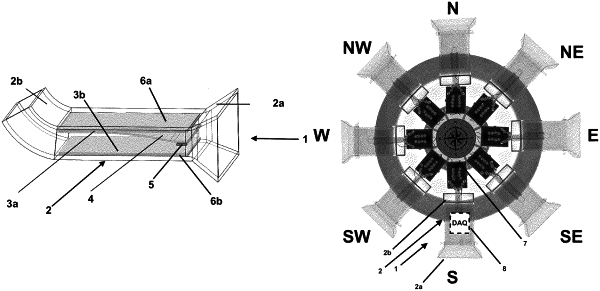| CPC G01P 5/08 (2013.01) [C08J 5/18 (2013.01); H02N 1/04 (2013.01); B33Y 80/00 (2014.12)] | 10 Claims |

|
1. A self-driven wind speed and wind direction sensing device, wherein the self-driven wind speed and wind direction sensing device comprises:
eight triboelectric nanogenerators (TENGs); and
an electrometer data acquisition (DAQ) board, wherein each of the TENGs is arranged on the electrometer DAQ board;
wherein each of the TENGs comprises
a wind cavity,
a plurality of triboelectric layers,
a hydroxyethyl cellulose (HEC) film,
a top electrode comprising a conductive material layer adhered or plated to the upper surface of the inner wall of the wind cavity,
a bottom electrode comprising a conductive material layer adhered or plated to the upper surface of the inner wall of the wind cavity,
a rectifier bridge connected to the top electrode and bottom electrode,
wherein the wind cavity is provided with an inlet end and an outlet end,
wherein one triboelectric layer of the plurality of triboelectric layers is each fixedly adhered to completely cover the top electrode and the bottom electrode, respectively,
wherein the wind cavity is provided with a horizontally arranged support bar perpendicular to a wind direction in a middle adjacent to the inlet end of the wind cavity, and
wherein the HEC film comprises one end fixedly adhered to the support bar, and the other end of the HEC film extending freely toward the outlet end of the wind cavity;
wherein the wind cavity comprises the inlet end connected to a horn-shaped cavity and the outlet end connected to a curved upward cavity;
wherein the wind cavity is formed by 3D printing;
wherein the HEC film was prepared by: adding a fiber powder to water or an ethanol aqueous solution, adding a plasticizer, heating in a water bath to mix the solution evenly, evaporating a solvent, and drying to obtain the HEC film;
wherein the rectifier bridge comprises four pins and wherein lead wires connect the top electrode and the bottom electrode to two of the pins at an alternating-current (AC) terminal of the rectifier bridge and two other pins of the rectifier bridge are for connecting to an external power receiving equipment;
wherein the eight TENGs are distributed on a circumference of a ring at an interval of a central angle of substantially 45° and cooperating with the electrometer DAQ board.
|